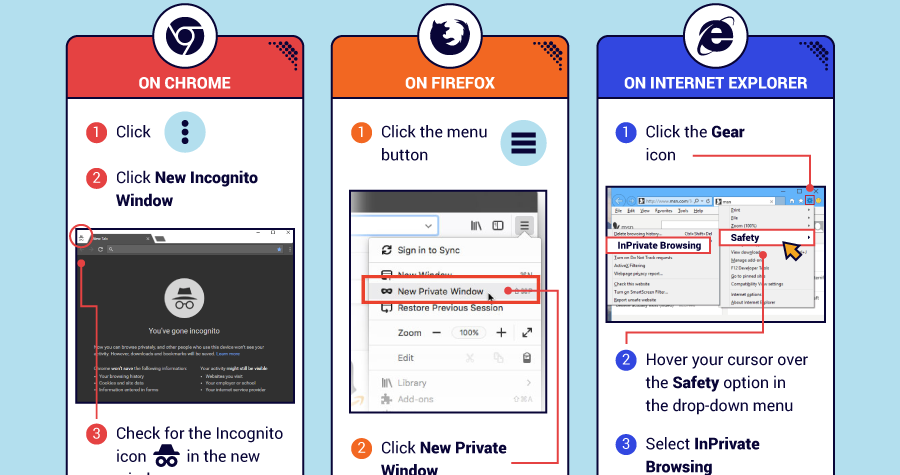Technology
How to Be Invisible on the Internet
Everywhere you look, concerns are mounting about internet privacy.
Although giving up your data was once an afterthought when gaining access to the newest internet services such as Facebook and Uber, many people have had their perspective altered by various recent scandals, billions of dollars of cybertheft, and a growing discomfort around how their personal data may be used in the future.
More people want to opt out of this data collection, but aside from disconnecting entirely or taking ludicrous measures to safeguard information, there aren’t many great options available to limit what is seen and known about you online.
The Next Best Thing
It may not be realistic to use Tor for all online browsing, so why not instead look at taking more practical steps to reducing your internet footprint?
Today’s infographic comes to us from CashNetUSA, and it gives a step-by-step guide – that anyone can follow – to limit the amount of personal data that gets collected on the internet.

As you can see, you can take simple steps to limit the amount of personal information you give up online.
To be absolutely clear, these actions will not reduce your footprint to nothing – but they will make many important categories of data invisible for all intents and purposes.
Basic Building Blocks
The simple actions that can be taken fall into three major realms: internet browsers, social networks, and mobile phones.
1. Internet Browsers:
Whether you are using Chrome, Firefox, or Internet Explorer, there are easy things you can do to increase privacy. These include using private browsing, blocking third-party cookies, and tailoring the permissions for websites that you access.
2. Social Media Platforms
Major social networks have options built-in for users seeking privacy – it’s just many people don’t know they are there. On Facebook, for example, you can prevent your name being linked to ads – and on Twitter, you can prevent Twitter from tracking you.
3. Mobile Phones
We live more and more on our smartphones, but thankfully there are options here as well. You can block ad tracking on Safari, or opt out of ad personalization on Android. There is even a simple setting on Android that allows you to encrypt your phone.
Technology
Visualizing AI Patents by Country
See which countries have been granted the most AI patents each year, from 2012 to 2022.

Visualizing AI Patents by Country
This was originally posted on our Voronoi app. Download the app for free on iOS or Android and discover incredible data-driven charts from a variety of trusted sources.
This infographic shows the number of AI-related patents granted each year from 2010 to 2022 (latest data available). These figures come from the Center for Security and Emerging Technology (CSET), accessed via Stanford University’s 2024 AI Index Report.
From this data, we can see that China first overtook the U.S. in 2013. Since then, the country has seen enormous growth in the number of AI patents granted each year.
| Year | China | EU and UK | U.S. | RoW | Global Total |
|---|---|---|---|---|---|
| 2010 | 307 | 137 | 984 | 571 | 1,999 |
| 2011 | 516 | 129 | 980 | 581 | 2,206 |
| 2012 | 926 | 112 | 950 | 660 | 2,648 |
| 2013 | 1,035 | 91 | 970 | 627 | 2,723 |
| 2014 | 1,278 | 97 | 1,078 | 667 | 3,120 |
| 2015 | 1,721 | 110 | 1,135 | 539 | 3,505 |
| 2016 | 1,621 | 128 | 1,298 | 714 | 3,761 |
| 2017 | 2,428 | 144 | 1,489 | 1,075 | 5,136 |
| 2018 | 4,741 | 155 | 1,674 | 1,574 | 8,144 |
| 2019 | 9,530 | 322 | 3,211 | 2,720 | 15,783 |
| 2020 | 13,071 | 406 | 5,441 | 4,455 | 23,373 |
| 2021 | 21,907 | 623 | 8,219 | 7,519 | 38,268 |
| 2022 | 35,315 | 1,173 | 12,077 | 13,699 | 62,264 |
In 2022, China was granted more patents than every other country combined.
While this suggests that the country is very active in researching the field of artificial intelligence, it doesn’t necessarily mean that China is the farthest in terms of capability.
Key Facts About AI Patents
According to CSET, AI patents relate to mathematical relationships and algorithms, which are considered abstract ideas under patent law. They can also have different meaning, depending on where they are filed.
In the U.S., AI patenting is concentrated amongst large companies including IBM, Microsoft, and Google. On the other hand, AI patenting in China is more distributed across government organizations, universities, and tech firms (e.g. Tencent).
In terms of focus area, China’s patents are typically related to computer vision, a field of AI that enables computers and systems to interpret visual data and inputs. Meanwhile America’s efforts are more evenly distributed across research fields.
Learn More About AI From Visual Capitalist
If you want to see more data visualizations on artificial intelligence, check out this graphic that shows which job departments will be impacted by AI the most.
-

 Green1 week ago
Green1 week agoRanking the Top 15 Countries by Carbon Tax Revenue
-

 Technology2 weeks ago
Technology2 weeks agoThe Stock Performance of U.S. Chipmakers So Far in 2024
-

 Markets2 weeks ago
Markets2 weeks agoCharted: Big Four Market Share by S&P 500 Audits
-

 Real Estate2 weeks ago
Real Estate2 weeks agoRanked: The Most Valuable Housing Markets in America
-

 Money2 weeks ago
Money2 weeks agoWhich States Have the Highest Minimum Wage in America?
-

 AI2 weeks ago
AI2 weeks agoRanked: Semiconductor Companies by Industry Revenue Share
-

 Travel2 weeks ago
Travel2 weeks agoRanked: The World’s Top Flight Routes, by Revenue
-

 Countries2 weeks ago
Countries2 weeks agoPopulation Projections: The World’s 6 Largest Countries in 2075















